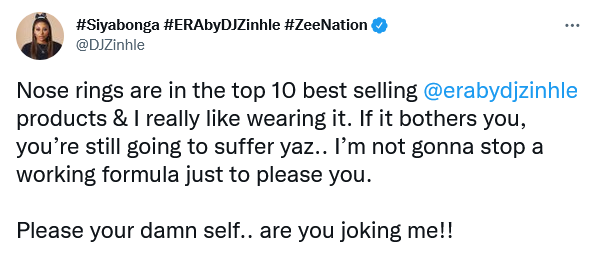DJ Zinhle Has a Message for Those Pressed By Her Nose Ring

DJ Zinhle Has a Message for Those Pressed By Her Nose Ring. One thing about DJ Zinhle, she is a very smart entrepreneur. Not only does she sell her brands by word of mouth, she also uses them on herself. She makes sure she wears Hair Majesty wigs, Era by DJ Zinhle jewellery and she always toasts to her Boulevard Nectar Rosé wine.
The affluent businesswoman also faces challenges just like any other business person out there. Here and there, she deals with some criticism. One of her major fashion statements is rocking a nose ring from her Era by DJ Zinhle jewellery line. Sadly, there are some people who don’t warm up to nose rings, and they have had an opinion on Zinhle rocking one.
If you are one of those people not comfortable with seeing Zinhle rocking her nose ring, then you have to be strong. According to Zinle, nose rings are in the top 10 selling jewellery products from her line, and she loves them to bits. Hence she won’t stop a working formula to please people.
“Nose rings are in the top 10 best selling @erabydjzinhle products & I really like wearing it. If it bothers you, you’re still going to suffer yaz.. I’m not gonna stop a working formula just to please you. Please your damn self.. are you joking me,” Zinhle fired a shot at critics.





